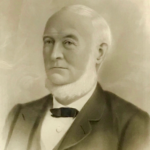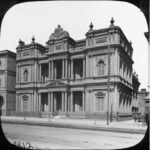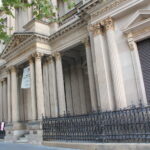Edmund William Wright was born on 4th April 1824 near London, England, the son of Stephen Wright, who is said to have worked as the Master of Ordnance at the Tower of London. The family was of French descent and retained a summer house in the north of France, where Wright was strongly influenced by the Renaissance architecture of Paris and Touraine. He learnt the trades of architect, surveyor and engineer while articled to a borough surveyor in the London suburb of Bermondsey, and in 1849 emigrated to South Australia, where he established a business as an architect and engineer. Commissions, however, were slow in coming and Wright worked with his brother Edward as a land agent and broker and later as an insurance agent and for a building society.
In the early 1850s he tried his luck on the Victorian goldfields, along with thousands of other hopefuls, but by 1852 had returned to Adelaide. On 26th October 1852 he married a widow, Agnes Jane Stuckey (née Rippingville), and they had four children, three of whom survived to adulthood. Work for Wright as an architect slowly increased, as did his standing in the community. In 1859 he was Mayor of the City of Adelaide and by 1860 had a well established practice as well as several other interests. He managed his brother’s insurance business and was on the boards of various mining companies.
Edmund Wright was typical of the new breed of versatile Victorian architects. He was capable of designing any building, be it civic, ecclesiastical, domestic or commercial, in any style, but was most comfortable when using French or Italian Renaissance idioms. He was one of the founding members of the short-lived Society of Architects, Engineers and Surveyors, established in Adelaide in 1858, and in a speech to the Society he spoke of the need to adopt an architectural philosophy reminiscent of northern Italy, given its close similarities in climate and environment to Adelaide. He advocated flat roofs rather than steeply-pitched ones, lofty well-proportioned rooms for coolness, and windows ‘possessing a judicious amount of decoration so as to reduce the quantity of glass without producing a gaol-like external appearance’.
Wright worked in association with a number of architects during his career and many of Adelaide’s best known city buildings were designed by a practice that included him. He was the architect for ‘Belmont’ in Brougham Place, North Adelaide (1858), the Methodist Meeting Hall off Pirie Street (1863) and the Adelaide Town Hall (1863-66). With E.J. Woods and the Hamilton brothers, he designed St. Laurence’s Church and Priory in Buxton Street, North Adelaide (1867-68), the west wing of the General Post Office (1867-72) and the Jewish Synagogue (1871). He was also the co-designer of the Congregational Church in Brougham Place, North Adelaide (1861), the Bank of Adelaide at 81 King William Street (1878-80) and the west wing of Parliament House (1883-89). Wright was responsible for many buildings outside the city area, including ‘Linden’ at Burnside, ‘Paringa Hall’ at Brighton, ‘Athelney’ at College Park and the Princess Royal homestead at Burra.
Perhaps the finest example of his work is the elegant Edmund Wright House, designed in conjunction with Lloyd Tayler and built in 1878 for the Bank of South Australia. It features marble columns and floor tiles in the entrance hall, a magnificent banking chamber with an elaborately decorated ceiling, and richly carved stonework by Scottish sculptor William Maxwell and London sculptor Joseph Durham. Threatened with demolition in 1971, it was saved by a public campaign to preserve it as one of Adelaide’s irreplaceable treasures.
Edmund Wright was highly regarded by his peers and in 1886 was elected first Vice-President of the South Australian Institute of Architects. He died on 5th August 1888 and was buried at North Road Cemetery.







Comments